Automated versus Manual Mapping of Gravel Pit Lakes from South-Eastern Romania for Detailed Morphometry and Vegetation
Abstract
:1. Introduction
2. Methods
2.1. Morphometric Analyses
2.2. Remote Sensing
3. Results and Discussions
3.1. Morphometric Analyses
3.2. Evaluation of the Spatial Distribution of Gravel Pit Lakes Using Sentinel 2A Datasets
3.3. Assessment of Vegetation Dynamics Based on Satellite-Derived LAI
4. Conclusions
Author Contributions
Funding
Institutional Review Board Statement
Informed Consent Statement
Data Availability Statement
Conflicts of Interest
Appendix A

References
- Liu, S.; Li, W.; Qiao, W.; Wang, Q.; Hu, Y.; Wang, Z. Effect of natural conditions and mining activities on vegetation variations in arid and semiarid mining regions. Ecol. Indic. 2019, 103, 331–345. [Google Scholar] [CrossRef]
- Yu, L.; Xu, Y.; Xue, Y.; Li, X.; Cheng, Y.; Liu, X.; Gong, P. Monitoring surface mining belts using multiple remote sensing datasets: A global perspective. Ore Geol. Rev. 2018, 101, 675–687. [Google Scholar] [CrossRef]
- DeWitt, J.D.; Chirico, P.G.; Bergstresser, S.E.; Warner, T.A. Multi-scale 46-year remote sensing change detection of diamond mining and land cover in a conflict and post-conflict setting. Remote Sens. Appl. Soc. Environ. 2017, 8, 126–139. [Google Scholar] [CrossRef]
- Nixdorf, B.; Rücker, J.; Grüneberg, B. Importance of internal nitrogen recycling on water quality and cyanobacterial biomass in a shallow polymictic lake (Lake Langer See, Germany). In Proceedings of the 3rd International Conference Water Resources and Wetlands, Tulcea, Romania, 8–10 September 2014. [Google Scholar]
- Asaeda, T.; Sanjayaa, K. The influence of the gravel sediment shortage in midstream river channels on riparian vegetation colonization. In Proceedings of the 3rd International Conference “Water resources and wetlands”, Tulcea, Romania, 8–10 September 2014. [Google Scholar]
- Davies, P.; Lawrence, S.; Turnbull, J.; Rutherfurd, I.; Grove, J.; Silvester, E.; Macklin, M. Mining modification of river systems: A case study from the Australian gold rush. Geoarchaeology 2020, 35, 384–399. [Google Scholar] [CrossRef]
- Schultze, M.; Pokrandt, K.H.; Hille, W. Pit lakes of the Central German lignite mining district: Creation, morphometry and water quality aspects. Limnologica 2010, 40, 148–155. [Google Scholar] [CrossRef] [Green Version]
- Gastescu, P. Lacurile Din România—Limnologie Regională; Editura Academiei Republicii Socialiste România: Bucharest, Romania, 1971. [Google Scholar]
- Mollema, P.N.; Antonellini, M.; Dinelli, E.; Greggio, N.; Stuyfzand, P.J. The influence of flow-through saline gravel pit lakes on the hydrologic budget and hydrochemistry of a Mediterranean drainage basin. Limnol. Oceanogr. 2015, 60, 2009–2025. [Google Scholar] [CrossRef] [Green Version]
- Rzymski, P.; Klimaszyk, P.; Marszelewski, W.; Borowiak, D.; Mleczek, M.; Nowiński, K.; Poniedziałek, B. The chemistry and toxicity of discharge waters from copper mine tailing impoundment in the valley of the Apuseni Mountains in Romania. Environ. Sci. Pollut. Res. 2017, 24, 21445–21458. [Google Scholar] [CrossRef] [Green Version]
- Cobelas, M.A.; García-Morato, C.R. That twenty years is nothing for gravel-pit limnology. Limnetica 2021, 40, 169–187. [Google Scholar] [CrossRef]
- Hupfer, M.; Fischer, P.; Friese, K. Phosphorus retention mechanisms in the sediment of a eutrophic mining lake. Water Air Soil Pollut 1998, 108, 341–352. [Google Scholar] [CrossRef]
- Nixdorf, B.; Uhlmann, W.; Lessmann, D. Potential for remediation of acidic mining lakes evaluated by hydrogeochemical modelling: Case study Grünewalder Lauch (Plessa 117, Lusatia/Germany). Limnologica 2010, 40, 167–174. [Google Scholar] [CrossRef] [Green Version]
- Weilhartner, A.; Muellegger, C.; Kainz, M.; Mathieu, F.; Hofmann, T.; Battin, T.J. Gravel pit lake ecosystems reduce nitrate and phosphate concentrations in the outflowing groundwater. Sci. Total Environ. 2012, 420, 222–228. [Google Scholar] [CrossRef] [PubMed]
- Trevisan, R.; Zancan, S.; Naselli-Flores, L. Phytoplankton assemblages in two gravel-pit lakes with different morphologies. Int. Ver. Für Theor. Und Angew. Limnol. Verh. 2000, 27, 2895–2898. [Google Scholar] [CrossRef]
- Søndergaard, M.; Larsen, S.E.; Johansson, L.S.; Lauridsen, T.L.; Jeppesen, E. Ecological classification of lakes: Uncertainty and the influence of year-to-year variability. Ecol. Indic. 2015, 61, 248–257. [Google Scholar] [CrossRef]
- Søndergaard, M.; Lauridsen, T.L.; Johansson, L.S.; Jeppesen, E. Gravel pit lakes in Denmark: Chemical and biological state. Sci. Total Environ. 2018, 612, 9–17. [Google Scholar] [CrossRef] [PubMed]
- Chamberlain, D.A.; Possingham, H.P.; Phinn, S.R. Decision-making with ecological process for coastal and marine planning: Current literature and future directions. Aquat. Ecol. 2021, 56, 1–19. [Google Scholar] [CrossRef]
- Blanchette, M.L.; Lund, M.A. Pit lakes are a global legacy of mining: An integrated approach to achieving sustainable ecosystems and value for communities. Curr. Opin. Environ. Sustain. 2016, 23, 28–34. [Google Scholar] [CrossRef]
- McCullough, C.D.; Schultze, M.; Vandenberg, J. Realizing beneficial end uses from abandoned pit lakes. Minerals 2020, 10, 133. [Google Scholar] [CrossRef] [Green Version]
- Șerban, G. Anthropo-saline and karsto-saline lakes from Ocna Sugatag–Maramures (Romania). Lakes Reserv. Ponds 2008, 1, 80–89. [Google Scholar]
- Sorocovschi, V. The Mineralisation Degree and Chemical Composition of The Lakes in The Transylvanian Plain. Lakes Reserv. Ponds 2009, 3, 13–24. [Google Scholar]
- Şerban, G.; Antonie, M.; Roman, C. Remanent lakes formed through the work of kaolin exploiting from Aghireşu (Cluj County). Lakes Reserv. Ponds 2009, 3, 40–52. [Google Scholar]
- Bătinaş, R.H. The Lakes from Roşia Montană. Lakes Reserv. Ponds 2009, 3, 85–93. [Google Scholar]
- Zaharia, L.; Grecu, F.; Ioana-Toroimac, G.; Neculau, G. Sediment Transport and River Channel Dynamics in Romania-Variability and Control Factors; INTECH Open Access Publisher: London, UK, 2011. [Google Scholar]
- Diaconu, D.C.; Bretcan, P.; Peptenatu, D.; Tanislav, D.; Mailat, E. The importance of the number of points, transect location and interpolation techniques in the analysis of bathymetric measurements . J. Hydrol. 2019, 570, 774–785. [Google Scholar] [CrossRef]
- Bie, W.; Fei, T.; Liu, X.; Liu, H.; Wu, G. Small water bodies mapped from Sentinel-2 MSI (MultiSpectral Imager) imagery with higher accuracy. Int. J. Remote Sens. 2020, 41, 7912–7930. [Google Scholar] [CrossRef]
- Marcaccio, J.V.; Chow-Fraser, P. Mapping options to track invasive Phragmites australis in the Great Lakes basin in Canada. In Proceedings of the 3 rd International Conference “Water resources and wetlands”, Tulcea, Romania, 8–10 September 2014. [Google Scholar]
- Luo, N.; Yu, R.; Mao, D.; Wen, B.; Liu, X. Spatiotemporal variations of wetlands in the northern Xinjiang with relationship to climate change. Wetl. Ecol. Manag. 2021, 29, 617–631. [Google Scholar] [CrossRef]
- Ongun Sevindik, T.; Erdoğan, M.; Tunca, H.; Güzel, U.; Erturaç, M.K. The effects of inter-annual fluctuations in precipitation, lake surface area, and wind speed on phytoplankton structure in three shallow Mediterranean lakes (Sakarya, Turkey). Aquat. Ecol. 2022, 1–22. [Google Scholar] [CrossRef]
- Weithoff, G.; Moser, M.; Kamjunke, N.; Gaedke, U.; Weisse, T. Lake morphometry and wind exposure may shape the plankton community structure in acidic mining lakes. Limnologica 2010, 40, 161–166. [Google Scholar] [CrossRef] [Green Version]
- Marszelewski, W.; Dembowska, E.A.; Napiórkowski, P.; Solarczyk, A. Understanding abiotic and biotic conditions in post-mining pit lakes for efficient management: A case study (Poland). Mine Water Environ. 2017, 36, 418–428. [Google Scholar] [CrossRef] [Green Version]
- Grenfell, M.C.; Abrahams, E.; Fisher, R.M. Analysis and conceptual geospatial modelling of the intermediary role of wetlands in drylands in post-fire material flux dynamics, Silvermine River catchment, Cape Town. Wetl. Ecol. Manag. 2022, 1–23. [Google Scholar] [CrossRef]
- Meybeck, M. Global distribution of lakes. In Physics and Chemistry of Lakes; Lerman, A., Imboden, D.M., Gat, J.R., Eds.; Springer: Berlin/Heidelberg, Germany, 1995; pp. 1–35. [Google Scholar] [CrossRef]
- Kalff, J. Limnology: Inland Water Ecosystems, 2nd ed.; Upper Saddle River (NJ): Prentice Hall, NJ, USA, 2002. [Google Scholar]
- Lehner, B.; Döll, P. Development and validation of a global database of lakes, reservoirs and wetlands. J. Hydrol. 2004, 296, 1–22. [Google Scholar] [CrossRef]
- Downing, J.A.; Prairie, Y.T.; Cole, J.J.; Duarte, C.M.; Tranvik, L.J.; Striegl, R.G.; Middelburg, J.J. The global abundance and size distribution of lakes, ponds, and impoundments. Limnol. Oceanogr. 2006, 51, 2388–2397. [Google Scholar] [CrossRef] [Green Version]
- Lewis, W.M. Global primary production of lakes: 19th Baldi Memorial Lecture. Inland Waters 2011, 1, 1–28. [Google Scholar] [CrossRef] [Green Version]
- Cael, B.B.; Seekell, D.A. The size-distribution of Earth’s lakes. Sci. Rep. 2016, 6, 1–8. [Google Scholar] [CrossRef] [PubMed] [Green Version]
- Verpoorter, C.; Kutser, T.; Seekell, D.A.; Tranvik, L.J. A global inventory of lakes based on high-resolution satellite imagery. Geophys. Res. Lett. 2014, 41, 6396–6402. [Google Scholar] [CrossRef]
- Yang, Z.; Li, J.; Zipper, C.E.; Shen, Y.; Miao, H.; Donovan, P.F. Identification of the disturbance and trajectory types in mining areas using multitemporal remote sensing images. Sci. Total Environ. 2018, 644, 916–927. [Google Scholar] [CrossRef] [PubMed]
- Ovakoglou, G.; Alexandridis, T.K.; Crisman, T.L.; Skoulikaris, C.; Vergos, G.S. Use of MODIS satellite images for detailed lake morphometry: Application to basins with large water level fluctuations. Int. J. Appl. Earth Obs. Geoinf. 2016, 51, 37–46. [Google Scholar] [CrossRef]
- Sikora, M.; Cieśliński, R. Using GIS to discover changes in the local water cycle of wetlands—Case study Poblockie Peatbog. Limnol. Rev. 2016, 16, 155–164. [Google Scholar] [CrossRef] [Green Version]
- Diani, K.; Kacimi, I.; ElBelrhiti, H.; Zemzami, M.; Tabyaoui, H.; Masmoudi, L. Remote sensing and sig contribution for the identification of the fracturation influence on the drainage network architecture in the High Ziz River basin, Central High Atlas, Morocco. Limnol. Rev. 2019, 19, 149–158. [Google Scholar] [CrossRef] [Green Version]
- McFeeters, S.K. The use of the Normalized Difference Water Index (NDWI) in the delineation of open water features. Int. J. Remote Sens. 1996, 17, 1425–1432. [Google Scholar] [CrossRef]
- Wessels, R.; Kargel, J.; Kieffer, H. ASTER measurement of supraglacial lakes in the Mount Everest region of the Himalaya. Ann. Glaciol. 2002, 34, 399–408. [Google Scholar] [CrossRef] [Green Version]
- Xu, H.Q. Modification of normalized difference water index (NDWI) to enhance open water features in remotely sensed imagery. Int. J. Remote Sens. 2006, 27, 3025–3033. [Google Scholar] [CrossRef]
- Feyisa, G.L.; Meilby, H.; Fensholt, R.; Proud, S.R. Automated water extraction index: A new technique for surface water mapping using Landsat imagery. Remote Sens. Environ. 2014, 140, 23–35. [Google Scholar] [CrossRef]
- Wang, S.; Baig, M.H.A.; Zhang, L.; Jiang, H.; Ji, Y.; Zhao, H.; Tian, J. A simple enhanced water index (EWI) for percent surface water estimation using landsat data. IEEE J. Sel. Top. Appl. Earth Obs. Remote Sens. 2015, 8, 90–97. [Google Scholar] [CrossRef]
- Malahlela, O.E. Inland waterbody mapping: Towards improving discrimination and extraction of inland surface water features. Int. J. Remote Sens. 2016, 37, 4574–4589. [Google Scholar] [CrossRef]
- Wang, Z.; Liu, J.; Li, J.; Zhang, D.D. Multi-SpectralWater Index (MuWI): A native 10-m Multi-SpectralWater Index for accuratewater mapping on Sentinel-2. Remote Sens. 2018, 10, 1643. [Google Scholar] [CrossRef] [Green Version]
- Watson, C.S.; King, O.; Miles, E.S.; Quincey, D.J. Optimising NDWI supraglacial pond classification on Himalayan debris-covered glaciers. Remote Sens. Environ. 2018, 217, 414–425. [Google Scholar] [CrossRef]
- METER Group. Leaf Area Index (LAI): The Researcher’s Complete Guide. Available online: https://www.metergroup.com/en/meter-environment/education-guides/researchers-complete-guide-leaf-area-index-lai (accessed on 14 May 2022).
- Dunea, D.; Dincă, N. Improving land utilization using intensive grass-clover mixtures in forage production systems. Rom. Agric. Res. 2014, 31, 147–158. [Google Scholar]
- Myneni, R.; Knyazikhin, Y.; Park, T. 2015. MCD15A2H MODIS/Terra + Aqua Leaf Area Index/FPAR 8-day L4 Global 500 m SIN Grid V006 [Data Set]. NASA EOSDIS Land Processes DAAC. Available online: https://lpdaac.usgs.gov/products/mcd15a2hv006/ (accessed on 13 May 2022). [CrossRef]
- Asner, G.P.; Scurlock, J.M.; AHicke, J. Global synthesis of leaf area index observations: Implications for ecological and remote sensing studies. Glob. Ecol. Biogeogr. 2003, 12, 191–205. [Google Scholar] [CrossRef] [Green Version]
- Bagli, S.; Soille, P. Automatic delineation of shoreline and lake boundaries from Landsat satellite images. In Proceedings of the Initial ECO-IMAGINE GI and GIS for Integrated Coastal Management, Seville, Spain, 13–15 May 2004. [Google Scholar]
- Bardossy, A.; Schmidt, F. GIS approach to scale issues of perimeter-based shape indices for drainage basins. Hydrol. Sci. J. 2002, 47, 931–942. [Google Scholar] [CrossRef]
- Kopeć, D.; Sabat-Tomala, A.; Michalska-Hejduk, D.; Jarocińska, A.; Niedzielko, J. Application of airborne hyperspectral data for mapping of invasive alien Spiraea tomentosa L.: A serious threat to peat bog plant communities. Wetl. Ecol. Manag. 2020, 28, 357–373. [Google Scholar] [CrossRef] [Green Version]
- Mollema, P.N.; Antonellini, M. Water and (bio)chemical cycling in gravel pit lakes: A review and outlook. Earth Sci. Rev. 2016, 159, 247–270. [Google Scholar] [CrossRef]
- Gravelius, H. Grundrifi Der Gesamten Gewcisserkunde; Band I: Flufikunde Compendium of Hydrology, Rivers; Goschen: Berlin, Germany, 1914; Volume I. (In German) [Google Scholar]
- Hutchinson, G.E. A treatise on limnology. In Geography, Physics and Chemistry; Wiley: New York, NY, USA, 1957; Volume 1. [Google Scholar]
- Miller, V.C. A Quantitative Geomorphic Study of Drainage Basin Characteristics in the Clinch Mountain Area, Virginia and Tennessee; Project No. 389–042, Tech. Report No. 3; Office of Naval Research: Geography, Branch, 1953; pp. 1–30. [Google Scholar]
- Chorlev, R.J.; Malm, D.E.G.; Poaorzelski, H.A. A new standard for estimating basin shape. Am. J. Sei. 1957, 255, 138–141. [Google Scholar]
- Verpoorter, C.; Kutser, T.; Tranvik, L. Automated mapping of water bodies using Landsat multispectral data. Limnol. Oceanogr. Methods 2012, 10, 1037–1050. [Google Scholar] [CrossRef]
- Schumm, S.A. The evolution of drainage systems and slopes in badlands at Perth Amboy, New Jersey. Bull. Geol. Soc. Am. 1956, 67, 597–646. [Google Scholar] [CrossRef]
- Horton, R.E. Drainage-basin characteristics. Trans. Am. Geophys. Union 1932, 13, 350–361. [Google Scholar] [CrossRef]
- Roche, M. Hydrologie de Surface; Gauthier-Villars et ORSTOM: Paris, France, 1963. (In French) [Google Scholar]
- Borowiak, D.; Nowiński, K.; Grabowska, K. A new bathymetric survey of the Suwałki Landscape Park lakes. Limnol. Rev. 2016, 16, 185–197. [Google Scholar] [CrossRef] [Green Version]
- Langat, P.K.; Kumar, L.; Koech, R. Monitoring river channel dynamics using remote sensing and GIS techniques. Geomorphology 2019, 325, 92–102. [Google Scholar] [CrossRef]
- Hachemi, K.; Grecu, F.; Ioana-Toroimac, G.; Grigorie-Omrani, Ş.; Ozer, A.; Kuzucuoglu, C. The utility of morphometric parameters extracted from SAR radar images in the monitoring of the dynamics of the Danube Island system, Giurgiu-Călăraşi sector, Romania. Int. J. Des. Nat. Ecodynamics 2021, 16, 13–19. [Google Scholar] [CrossRef]
- Rouse, J.W.; Haas, R.H.; Schell, J.A.; Deering, D.W. Monitoring vegetation systems in the Great Plains with ERTS. In Proceedings of the Third Earth resources Technology Satellite-1 Symposium, Greenbelt: NASA SP-351, Washington, DC, USA; 1974; pp. 301–317. [Google Scholar]
- Gitelson, A.A.; Merzlyak, M.N. Remote Sensing of Chlorophyll Concentration in Higher Plant Leaves. Adv. Space Res. 1998, 22, 689–692. [Google Scholar] [CrossRef]
- Fan, L.; Gao, Y.; Brück, H.; Bernhofer, C. Investigating the relationship between NDVI and LAI in semi-arid grassland in Inner Mongolia using in-situ measurements. Theor. Appl. Climatol. 2009, 95, 151–156. [Google Scholar] [CrossRef]
- Jinling, S.; Jindi, W.; Zhiqiang, X.; Yuetiing, X. The method on generating LAI production by fusing BJ-1 remote sensing data and modis LAI product. IEEE Int. Geosci. Remote Sens. Symp. 2009, 4, IV-825–IV-828. [Google Scholar] [CrossRef] [Green Version]
- Hakanson, L. Lakes: Form and Function; The Blackburn Press: Caldwell, NJ, USA, 2004. [Google Scholar]
- Piasecki, A.; Marszelewski, W. Dynamics and consequences of water level fluctuations of selected lakes in the catchment of the Ostrowo-Gopło Channel. Limnol. Rev. 2014, 14, 187–194. [Google Scholar] [CrossRef] [Green Version]
- Emmrich, M.; Schälicke, S.; Hühn, D.; Lewin, C.; Arlinghaus, R. No differences between littoral fish community structure of small natural and gravel pit lakes in the northern German lowlands. Limnologica 2014, 46, 84–93. [Google Scholar] [CrossRef]
- Muellegger, C.; Weilhartner, A.; Battin, T.J.; Hofmann, T. Positive and negative impacts of five Austrian gravel pit lakes on groundwater quality. Sci. Total Environ. 2013, 443, 14–23. [Google Scholar] [CrossRef] [PubMed]
- Radulescu, C.; Pohoata, A.; Bretcan, P.; Tanislav, D.; Stihi, C.; Chelarescu, E. Quantification of major ions in groundwaters using analytical techniques and statistical approaches. Rom. Rep. Phys. 2017, 69, 705. [Google Scholar]
- Radulescu, C.; Bretcan, P.; Pohoata, A.; Tanislav, D.; Stirbescu, R.M. Assessment of drinking water quality using statistical analysis: A case study. Rom. J. Phys 2016, 61, 1604–1616. [Google Scholar]
- Popa, C.L.; Bretcan, P.; Radulescu, C.; Carstea, E.M.; Tanislav, D.; Dontu, S.I.; Dulama, I.D. Spatial distribution of groundwater quality in connection with the surrounding land use and anthropogenic activity in rural areas. Acta Montan. Slovaca 2019, 24, 73–87. [Google Scholar]
- Dunea, D.; Tanislav, D.; Stoica, A.; Bretcan, P.; Muratoreanu, G.; Frasin, L.N.; Alexandrescu, D.; Iliescu, N. ECO-PRACT: A project for developing the research competences of students regarding the monitoring of floristic composition in mountain grasslands. J. Sci. Arts 2018, 18, 225–238. [Google Scholar]
- Dunea, D.; Bretcan, P.; Tanislav, D.; Serban Gh Teodorescu, R.; Iordache, S.; Petrescu, N.; Tuchiu, E. Evaluation of Water Quality in Ialomita River Basin in Relationship with Land Cover Patterns. Water 2020, 12, 735. [Google Scholar] [CrossRef] [Green Version]
- Alexe, M.; Şerban, G. The evolution of heliotherm phenomenon in the karstosaline lake Ursu from Sovata, Romania. Carpathian J. Earth Environ. Sci. 2014, 9, 103–111. [Google Scholar]
- Piasecki, A.; Rajmund, S. Changing the geometry of basins and water resources of Lakes Gopło and Ostrowskie under the influence of anthropopressure. Limnol. Rev. 2014, 14, 33–43. [Google Scholar]
- Dunea, D.; Bretcan, P.; Purcoi, L.; Tanislav, D.; Serban, G.; Neagoe, A.; Iordache, V.; Iordache, S. Effects of riparian vegetation on evapotranspiration processes and water quality of small plain streams. Ecohydrol. Hydrobiol. 2021, 21, 629–640. [Google Scholar] [CrossRef]
- Dunea, D.; Moise, V. Artificial neural networks as support for leaf area modelling in crop canopies. In Proceedings of the 12th WSEAS International Conference on Computers, Heraklion, Greece, 23–25 July 2008; pp. 440–446. [Google Scholar]
- He, Y.; Guo, X.; Wilmshurst, J. Studying Mixed Grassland Ecosystems I: Suitable Hyperspectral Vegetation Indices. Can. J. Remote Sens. 2006, 32, 98–107. [Google Scholar] [CrossRef]
- Romano, G.; Ricci, G.F.; Gentile, F. Influence of Different Satellite Imagery on the Analysis of Riparian Leaf Density in a Mountain Stream. Remote Sens. 2020, 12, 3376. [Google Scholar] [CrossRef]
- Ricci, G.F.; Romano, G.; Leronni, V.; Gentile, F. Effect of check dams on riparian vegetation cover: A multiscale approach based on field measurements and satellite images for Leaf Area Index assessment. Sci. Total Environ. 2019, 657, 827–838. [Google Scholar] [CrossRef] [PubMed]
- Yan, K.; Park, T.; Yan, G.; Liu, Z.; Yang, B.; Chen, C.; Nemani, R.R.; Knyazikhin, Y.; Myneni, R.B. Evaluation of MODIS LAI/FPAR Product Collection 6. Part 2: Validation and Intercomparison. Remote Sens. 2016, 8, 460. [Google Scholar] [CrossRef] [Green Version]
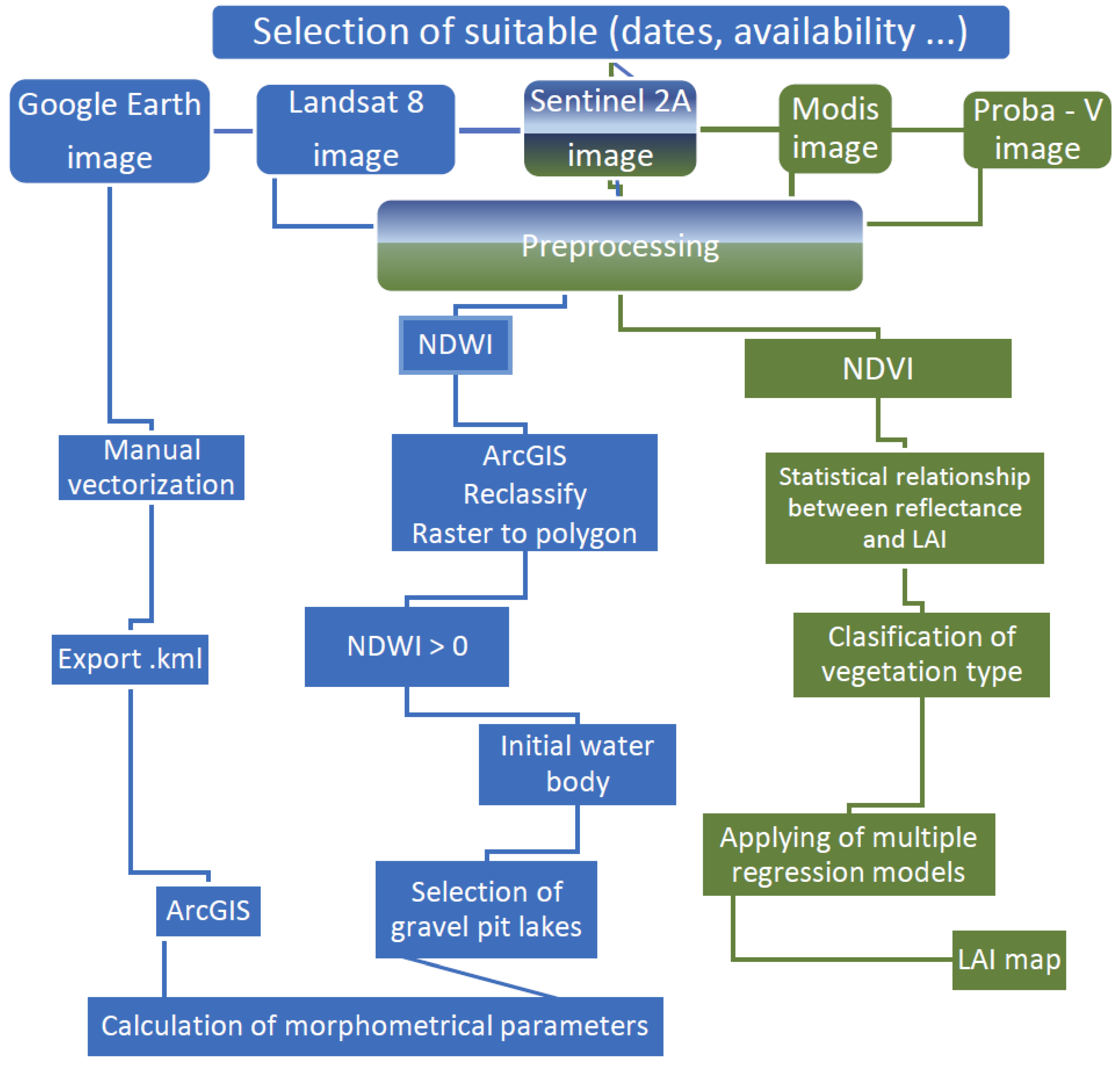



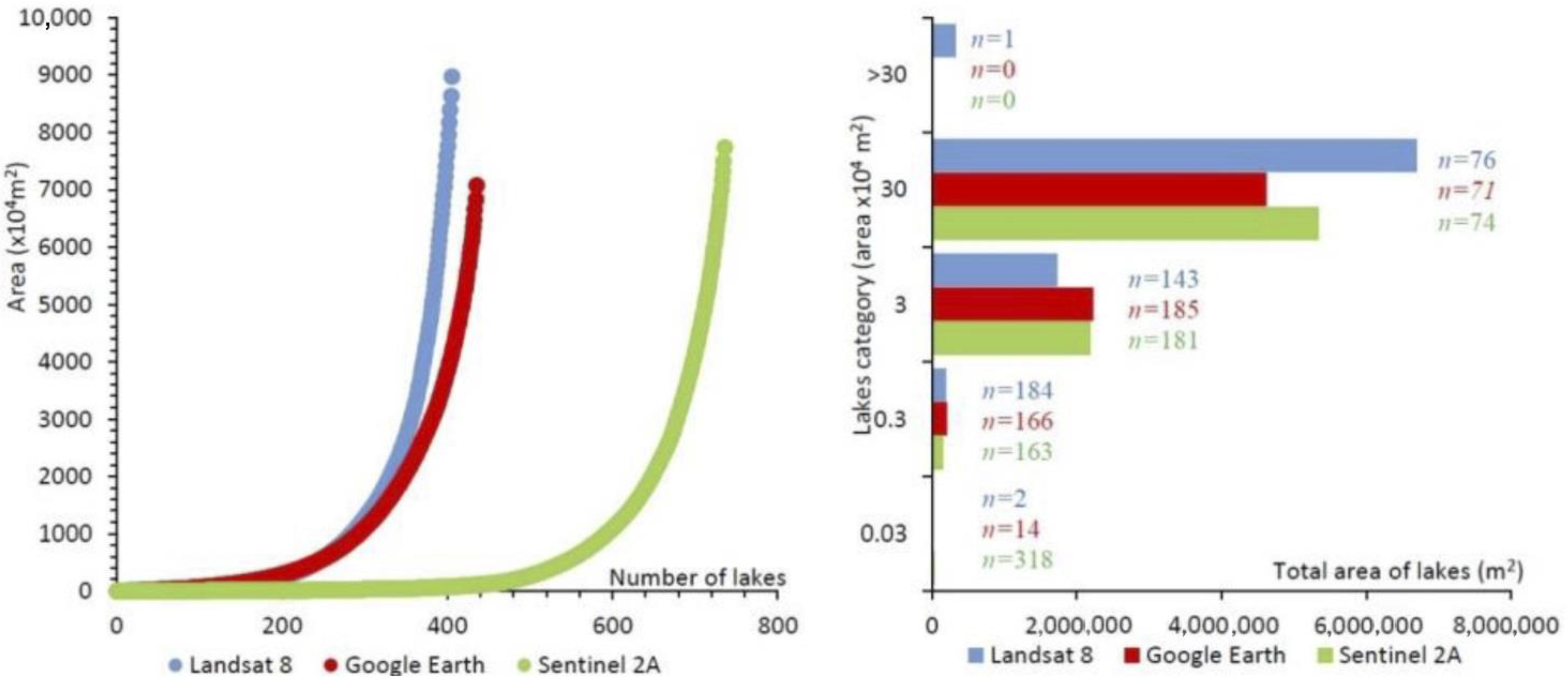



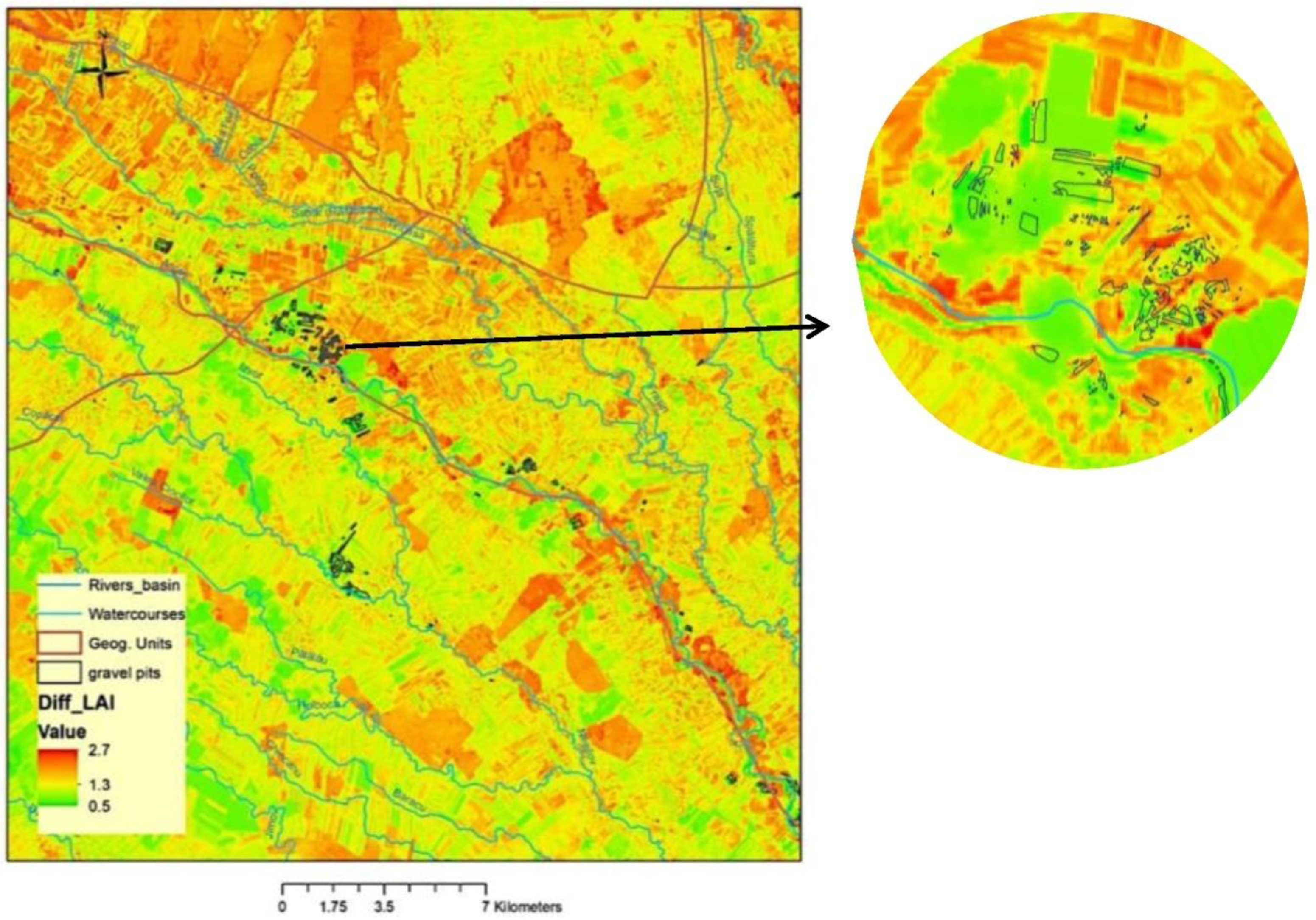

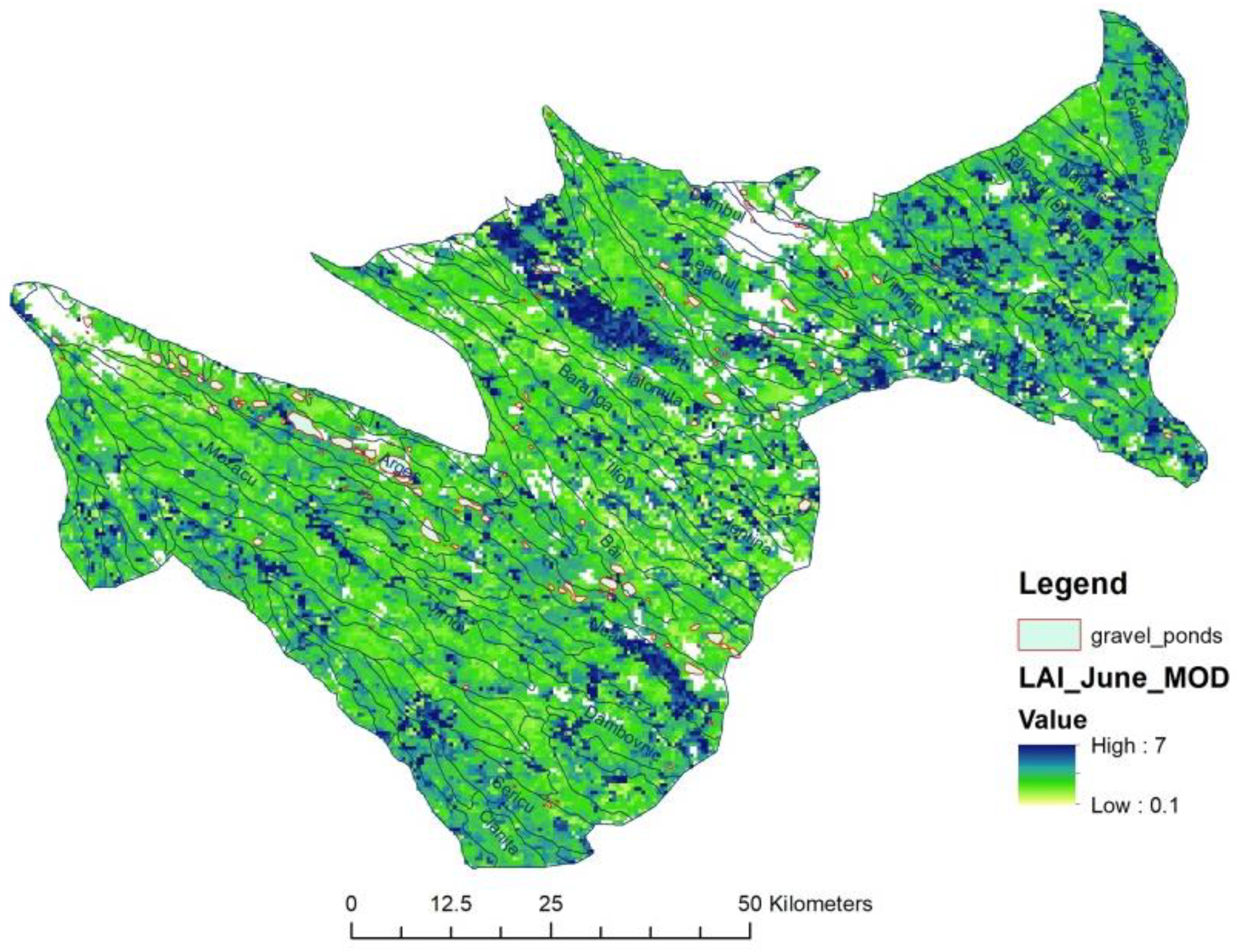
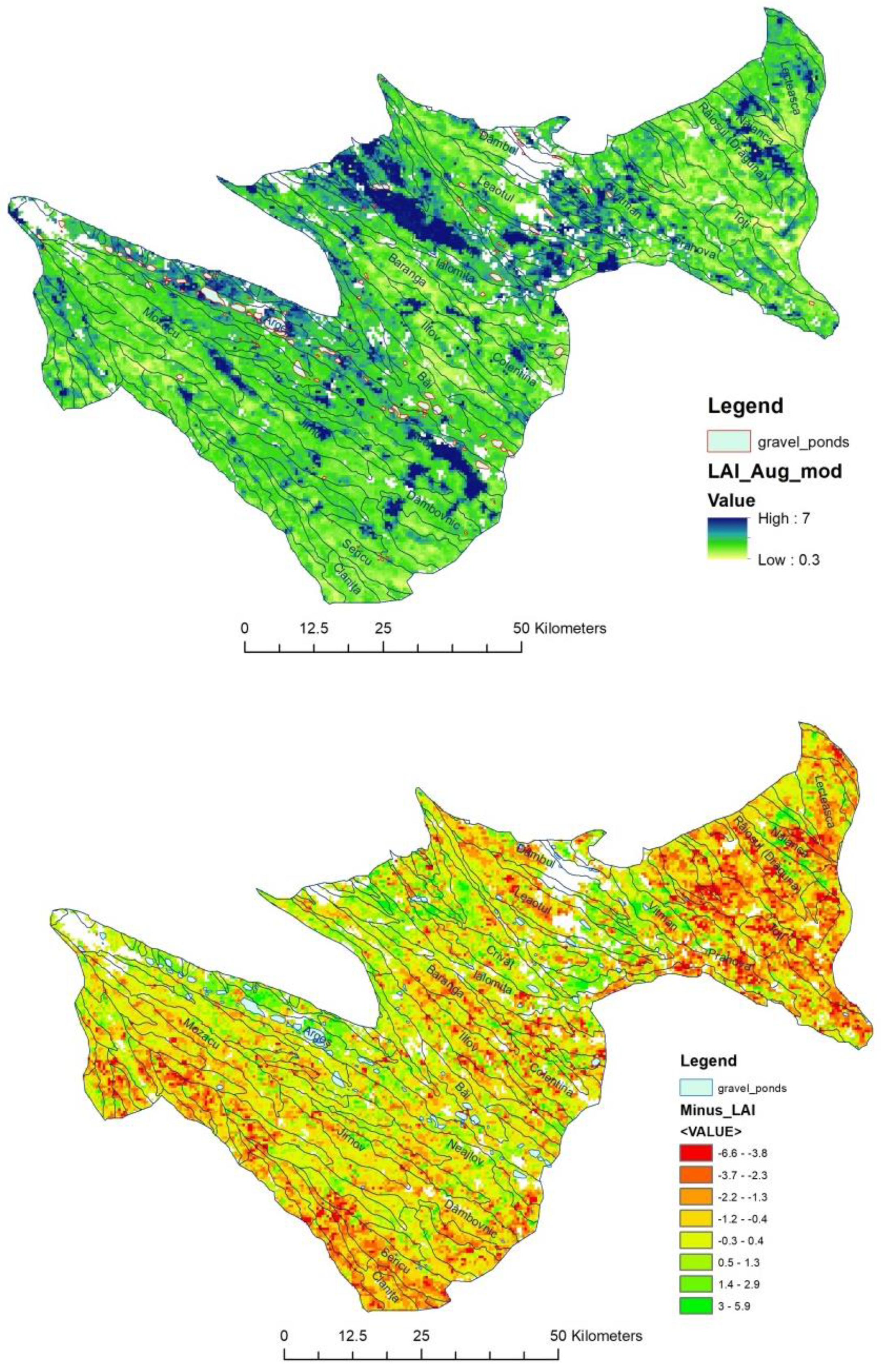
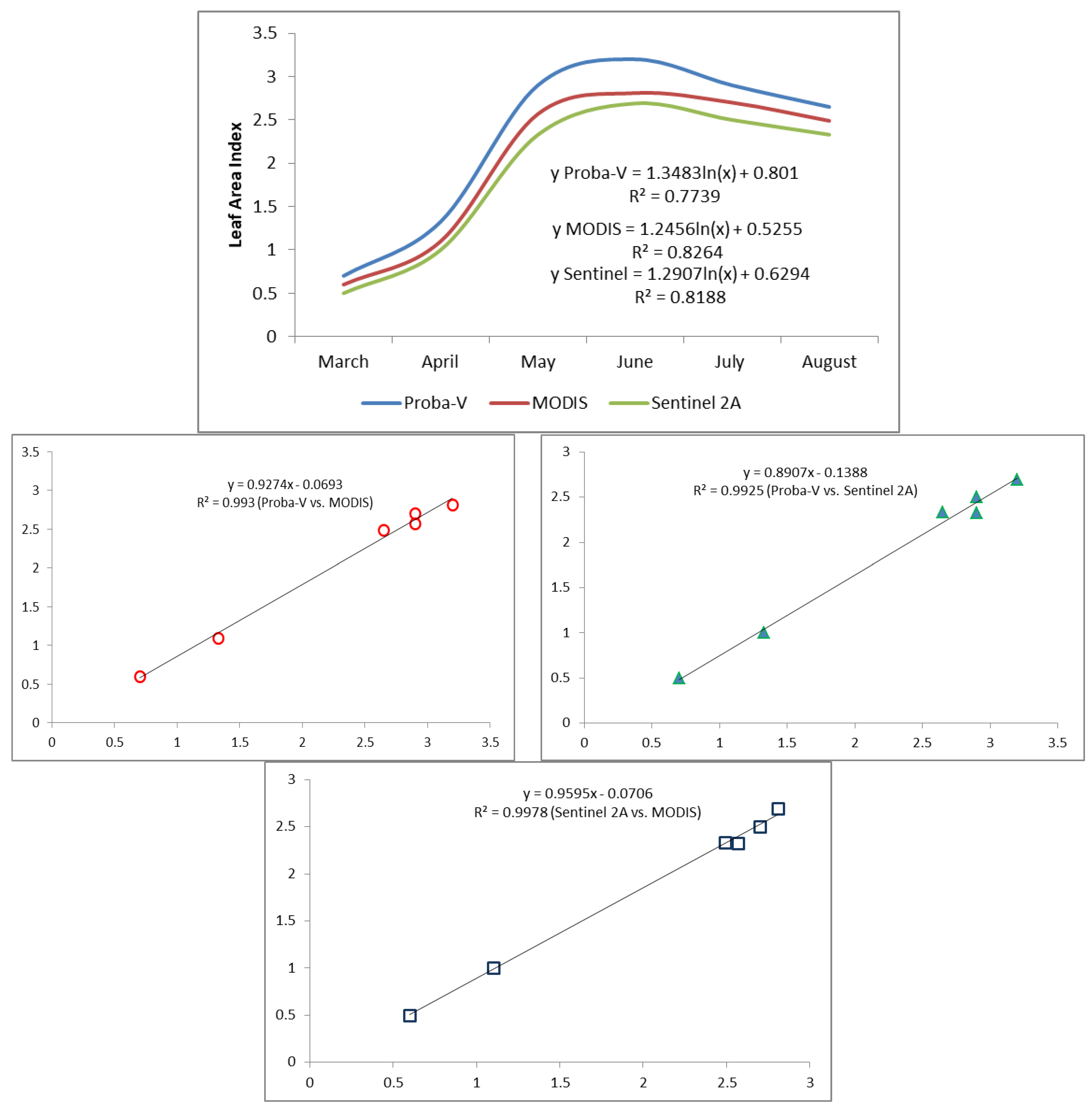
| Landsat 8 | Sentinel 2A | ||||||
|---|---|---|---|---|---|---|---|
| Type of Bands | Band No. | Wavelength (nm) | Spatial Resolution (m) | Type of Bands | Band No. | Wavelength (nm) | Spatial Resolution (m) |
| Coastal/Aerosol | 1 | 433–453 | 30 | Coastal Aerosol | 1 | 433–453 | 60 |
| Blue | 2 | 450–515 | 30 | Blue | 2 | 458–523 | 10 |
| Green | 3 | 525–600 | 30 | Green | 3 | 543–578 | 10 |
| Red | 4 | 630–680 | 30 | Red | 4 | 650–680 | 10 |
| Near Infrared | 5 | 845–885 | 30 | Red Edge 1 | 5 | 698–713 | 20 |
| Short Wavelength Infrared (SWIR 1) | 6 | 1560–1660 | 30 | Red Edge 2 | 6 | 733–748 | 20 |
| Short Wavelength Infrared (SWIR 2) | 7 | 2100–2300 | 30 | Red Edge 3 | 7 | 773–793 | 20 |
| Panchromatic | 8 | 500–680 | 15 | NIR | 8 | 785–900 | 10 |
| NIR Narrow | 8a | 855–875 | 20 | ||||
| Cirrus (SWIR) | 9 | 1360–1390 | 30 | Water Vapor | 9 | 935–955 | 60 |
| Long Wavelength Infrared | 10 | 1030–1130 | 100 | SWIR/Cirrus | 10 | 1360–1390 | 60 |
| Long Wavelength Infrared | 11 | 1150–1250 | 100 | SWIR 1 | 11 | 1566–1655 | 20 |
| SWIR 2 | 12 | 2100–2280 | 20 | ||||
| Landsat 8 (4.4.2019) | Google Earth (Spring 2019) | Sentinel 2A (26.4.2019) | Landsat 8 (4.4.2019) | Google Earth (Spring 2019) | Sentinel 2A (26.4.2019) | ||||
|---|---|---|---|---|---|---|---|---|---|
| Number of Lakes | 406 | 436 | 736 | Number of Lakes | 406 | 436 | 736 | ||
| Area (m2) | Maximum | 333,978 | 246,955 | 240,122 | Morton index spreading (MIS) | Maximum | 2.41 | 1.81 | 1.27 |
| Minimum | 124 | 35 | 64 | Minimum | 0.09 | 0.03 | 0.02 | ||
| Average | 22,081.37 | 16,227.06 | 10,505.3 | Average | 0.55 | 0.43 | 0.43 | ||
| St.dev. | 43,172.42 | 27,665.90 | 24,715.73 | St.dev. | 0.27 | 0.23 | 0.19 | ||
| Total | 8,965,036 | 7,075,001 | 7,731,899 | ||||||
| Perimeter/shore line (m) | Maximum | 3363 | 3430 | 3244 | Form factor (Ff) | Maximum | 1.89 | 1.42 | 1 |
| Minimum | 54 | 25 | 37 | Minimum | 0.07 | 0.03 | 0.01 | ||
| Average | 547.01 | 527.23 | 334.51 | Average | 0.43 | 0.33 | 0.34 | ||
| St.dev. | 632.06 | 487.64 | 475.64 | St.dev. | 0.21 | 0.18 | 0.15 | ||
| Total | 222,088 | 227,288 | 246,206 | ||||||
| Length (m) | Maximum | 967 | 1170 | 929 | Lake compacity (Lco) | Maximum | 12.75 | 32.15 | 63.13 |
| Minimum | 22 | 9 | 10 | Minimum | 0.52 | 0.70 | 1 | ||
| Average | 181.16 | 183.66 | 117.77 | Average | 2.90 | 4.45 | 3.67 | ||
| St.dev. | 185.65 | 157.30 | 151.29 | St.dev. | 1.55 | 4.20 | 3.04 | ||
| Maximum width (m) | Maximum | 608 | 477 | 473 | Area/lake length ratio (RA/L) | Maximum | 1.37 | 1.19 | 1 |
| Minimum | 11 | 5 | 9 | Minimum | 0.27 | 0.17 | 0.12 | ||
| Average | 101.32 | 83.09 | 57.42 | Average | 0.64 | 0.55 | 0.57 | ||
| St.dev. | 106.02 | 83.39 | 79.07 | St.dev. | 0.15 | 0.15 | 0.12 | ||
| Shoreline development index (SDI) | Maximum | 2.38 | 3.29 | 3.43 | Lake elongation (Le) | Maximum | 1.55 | 1.34 | 1.12 |
| Minimum | 1.07 | 1.03 | 1.07 | Minimum | 0.31 | 0.19 | 0.14 | ||
| Average | 1.36 | 1.50 | 1.39 | Average | 0.72 | 0.63 | 0.64 | ||
| St.dev. | 0.19 | 0.44 | 0.25 | St.dev. | 0.17 | 0.17 | 0.14 | ||
| Lake circularity (Lci) | Maximum | 0.86 | 0.92 | 0.86 | Length/maximum breadth ratio (RL/Bmax) | Maximum | 8.5 | 21.17 | 21.38 |
| Minimum | 0.17 | 0.09 | 0.08 | Minimum | 0.98 | 0.92 | 0.92 | ||
| Average | 0.56 | 0.52 | 0.54 | Average | 1.78 | 3.13 | 2.14 | ||
| St.dev. | 0.12 | 0.20 | 0.13 | St.dev. | 0.95 | 2.97 | 1.67 | ||
| Lemniscate ratio (K) | Maximum | 10.01 | 25.24 | 49.55 | |||||
| Minimum | 0.41 | 0.55 | 0.78 | ||||||
| Average | 2.27 | 3.49 | 2.88 | ||||||
| St.dev. | 1.22 | 3.30 | 2.38 | ||||||
| Name of Physico-Geographical Unit | Name of Subunit | Area (km2) | River | Gravel Pit Lakes from The Study Area | ||||||
|---|---|---|---|---|---|---|---|---|---|---|
| Number of Lakes | Surface Average (m2) | Surface Total (m2) | Average Shoreline Length (m) | Total Shoreline Length (m) | Length Average (m) | Maximum Width Average (m) | ||||
| Pitesti plain | Lunca Argesului | 218.78 | Arges left riverbank | 114 | 6724.94 | 766,643 | 263.45 | 30,033 | 95.22 | 40.48 |
| Pitesti | 723.75 | Arges right riverbank | 10 | 3406.30 | 34,063 | 193.20 | 1932 | 74.90 | 37.30 | |
| Total | 942.53 | 124 (16.84%) | 6457.30 | 800,706 | 257.78 | 31,965 | 93.58 | 40.22 | ||
| Gavanu plain | Gavanu | 1755.82 | Neajlov | 56 | 7662.00 | 429,072 | 283.53 | 15878 | 111.10 | 43.74 |
| Arges right riverbank | 40 | 11,896.65 | 475,866 | 405.53 | 16,221 | 145.68 | 70.53 | |||
| Glavacioc | 7 | 149.57 | 1047 | 55.28 | 387 | 21.00 | 14.14 | |||
| Total | 1755.82 | 103 (13.99%) | 9795.97 | 905,985 | 315.39 | 32,486 | 118.40 | 52.13 | ||
| Targoviste–Ploiesti plain | Targoviste | 405.33 | Dambovita left riverbank | 17 | 4838.82 | 82,260 | 266.65 | 4533 | 87.47 | 52.65 |
| Dambovita right riverbank | 5 | 5476.00 | 27,380 | 366.00 | 1830 | 119.40 | 71.00 | |||
| Ialomita right riverbank | 5 | 2405.40 | 12,027 | 180.00 | 900 | 63.80 | 38.40 | |||
| Cricovului | 294.36 | Ialomita left riverbank | 9 | 587.11 | 5284 | 80.77 | 727 | 28.00 | 18.77 | |
| Cricov right riverbank | 9 | 716.44 | 6448 | 116.88 | 1052 | 43.55 | 23.77 | |||
| Ploiesti | 672.80 | Cricov left riverbank | 16 | 4234.38 | 67,750 | 244.13 | 3906 | 93.31 | 38.56 | |
| Prahova left riverbank | 53 | 11,697.32 | 619,958 | 306.17 | 16,227 | 115.64 | 62.53 | |||
| Prahova right riverbank | 1 | 5759.00 | 5759 | 431 | 431 | 144.00 | 60.00 | |||
| Teleajen left riverbank | 25 | 11,153.12 | 278,828 | 377.00 | 9425 | 141.07 | 63.76 | |||
| Teleajen right riverbank | 12 | 2684.66 | 32,216 | 179.58 | 2155 | 69.16 | 40,092 | |||
| Total | 1372.49 | 152 (20.65%) | 7486.25 | 1,437,910 | 270.96 | 41,186 | 99.80 | 51.98 | ||
| Titu–Sarata plain | Titu | 1072.28 | Arges left riverbank | 302 | 11,867.32 | 3,583,931 | 357.52 | 107,917 | 122.82 | 59.12 |
| Ialomita left riverbank | 24 | 25718.21 | 617,237 | 646.13 | 15,507 | 200.46 | 121.08 | |||
| Puchenilor (Gherghitei) | 432.13 | Ialomita left riverbank | 6 | 35,875.83 | 215,255 | 779.66 | 4678 | 273.66 | 150.50 | |
| Prahova left riverbank | 12 | 24,816.25 | 297,795 | 532.42 | 6389 | 178.50 | 97.08 | |||
| Sarata | 729.99 | Ialomita left riverbank | 3 | 12,494.00 | 37,482 | 476.33 | 1429 | 156.00 | 102.66 | |
| Total | 2234.4 | 347 (47.14%) | 13,693.66 | 4,751,700 | 391.85 | 135,920 | 133.01 | 66.67 | ||
| Istritei plain | Valea Calugareasca | 244.45 | Teleajen left riverbank | 10 (1.35%) | 13559.80 | 135,598 | 459.50 | 4595 | 155.60 | 86.70 |
| Total study area | 736 | 10,505.3 | 7,731,899 | 334.51 | 246,152 | 117.77 | 57.42 | |||
| Area | Perimeter | Legth | Maximum Width | SDI | Lci | K | MIS | Ff | Lco | RA/L | Le | RL/Bmax | |
|---|---|---|---|---|---|---|---|---|---|---|---|---|---|
| Area | 1 | ||||||||||||
| Perimeter | 0.91 | 1 | |||||||||||
| Legth | 0.86 | 0.96 | 1 | ||||||||||
| MaximumWidth | 0.89 | 0.88 | 0.82 | 1 | |||||||||
| SDI | 0.26 | 0.51 | 0.48 | 0.22 | 1 | ||||||||
| Lci | −0.21 | −0.41 | −0.39 | −0.15 | −0.92 | 1 | |||||||
| K | −0.02 | 0.10 | 0.19 | −0.08 | 0.49 | −0.49 | 1 | ||||||
| MIS | 0.03 | −0.10 | −0.20 | 0.08 | −0.54 | 0.67 | −0.56 | 1 | |||||
| Ff | 0.03 | −0.10 | −0.20 | 0.08 | −0.54 | 0.67 | −0.56 | 1 | 1 | ||||
| Lco | −0.02 | 0.10 | 0.19 | −0.08 | 0.49 | −0.49 | 1 | −0.56 | −0.56 | 1 | |||
| RA/L | 0.03 | −0.12 | −0.23 | 0.10 | −0.61 | 0.72 | −0.67 | 0.98 | 0.98 | −0.67 | 1 | ||
| Le | 0.03 | −0.12 | −0.23 | 0.10 | −0.61 | 0.72 | −0.67 | 0.98 | 0.98 | −0.67 | 1 | 1 | |
| RL/Bmax | 0.06 | 0.24 | 0.37 | −0.04 | 0.58 | −0.53 | 0.69 | −0.56 | −0.56 | 0.69 | −0.67 | −0.67 | 1 |
Publisher’s Note: MDPI stays neutral with regard to jurisdictional claims in published maps and institutional affiliations. |
© 2022 by the authors. Licensee MDPI, Basel, Switzerland. This article is an open access article distributed under the terms and conditions of the Creative Commons Attribution (CC BY) license (https://creativecommons.org/licenses/by/4.0/).
Share and Cite
Bretcan, P.; Dunea, D.; Vintescu, G.; Tanislav, D.; Zelenakova, M.; Predescu, L.; Șerban, G.; Borowiak, D.; Rus, I.; Sabău, D.A.; et al. Automated versus Manual Mapping of Gravel Pit Lakes from South-Eastern Romania for Detailed Morphometry and Vegetation. Water 2022, 14, 1858. https://doi.org/10.3390/w14121858
Bretcan P, Dunea D, Vintescu G, Tanislav D, Zelenakova M, Predescu L, Șerban G, Borowiak D, Rus I, Sabău DA, et al. Automated versus Manual Mapping of Gravel Pit Lakes from South-Eastern Romania for Detailed Morphometry and Vegetation. Water. 2022; 14(12):1858. https://doi.org/10.3390/w14121858
Chicago/Turabian StyleBretcan, Petre, Daniel Dunea, Gabriel Vintescu, Danut Tanislav, Martina Zelenakova, Laurențiu Predescu, Gheorghe Șerban, Dariusz Borowiak, Ioan Rus, Daniel Andrei Sabău, and et al. 2022. "Automated versus Manual Mapping of Gravel Pit Lakes from South-Eastern Romania for Detailed Morphometry and Vegetation" Water 14, no. 12: 1858. https://doi.org/10.3390/w14121858
APA StyleBretcan, P., Dunea, D., Vintescu, G., Tanislav, D., Zelenakova, M., Predescu, L., Șerban, G., Borowiak, D., Rus, I., Sabău, D. A., Mititelu-Ionuș, O., Hueci, M., Moreanu, A., Samoila, E., Nguyen, H. D., Frasin, L. N., Mirea, I.-A., & Muntean, R.-C. (2022). Automated versus Manual Mapping of Gravel Pit Lakes from South-Eastern Romania for Detailed Morphometry and Vegetation. Water, 14(12), 1858. https://doi.org/10.3390/w14121858











